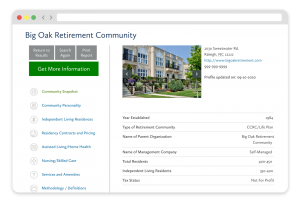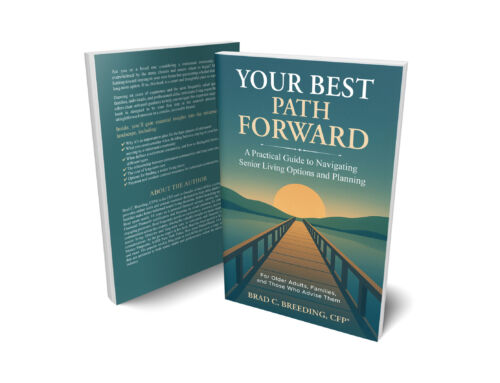Planning for the cost of long-term care can be one of the toughest financial challenges many families face. Whether utilizing in-home caregivers or moving to an assisted living or skilled nursing facility, long-term care costs can add up quickly, leaving older adults and their children searching for funding solutions. For homeowners, one often-overlooked option is a reverse mortgage, which taps into your home’s value to help pay for care without necessarily requiring you to sell or move out of the home.
Before diving in, it’s important to emphasize that this post should not be viewed as personal financial or lending advice. Be sure to talk with a financial professional and tax advisor before making any decisions about a reverse mortgage.
What is a reverse mortgage?
A reverse mortgage lets a homeowner who is age 62 or older borrow against their home’s equity and receive cash instead of making monthly mortgage payments. The balance of the loan grows over time because interest and fees are added to what you borrow. The home and its title remain in the borrower’s name while they live there.
A reverse mortgage loan comes due when none of the age-eligible borrowers lives in the home as a principal residence. This could be when the last borrower moves out, sells the house, or passes away.
Different reverse mortgage products exist, but the most commonly used type is the home equity conversion mortgage, or HECM, which accounts for about 95% of reverse mortgage loans. Available exclusively through Federal Housing Administration (FHA)-approved lenders, the HECM is the only reverse mortgage insured by the U.S. federal government, making it the safest and most regulated option.
>> Related: Why Moving Every 10 Years Can Make Sense in Retirement
Who qualifies for a reverse mortgage?
First, the federal HECM rules necessitate that the borrower(s) be at least 62 years old. To qualify, the home also must be maintained and kept in good condition, and the borrower must continue to pay their property taxes, homeowners’ insurance, and home maintenance costs. Prospective borrowers must also receive counseling from a U.S. Department of Housing and Urban Development (HUD)-certified reverse mortgage counselor.
Once the borrower permanently moves out of the home, the lender will typically allow 12 months to sell the home and repay the loan. In the case of a couple, this 12-month clock doesn’t start ticking until the second of the two borrowers permanently moves out of the home. This is an important provision for those who want to use a reverse mortgage to pay for the cost of a long-term care facility. (If the homeowners are using the reverse mortgage to pay for long-term care in their home- without moving out- then none of this applies.)
It’s also important to know that the borrower(s) must use the home as their principal residence. This caveat can be useful for those making a proactive move to a continuing care retirement community (CCRC, or life plan community).
Assuming you feel confident that your home will sell within a year, utilizing a reverse mortgage to fund your CCRC entrance fee, for example, can allow you to take more time with the CCRC moving process. Alternatively, you may opt to live part-time in the existing home, so you still meet the definition of full-time occupancy, and part-time in the CCRC until the home sells. (You must live in your own home for more than six months out of the year to meet the permanent occupancy definition.) This may not always make good economic sense, but it’s an option.
This approach also eliminates the risk of having a change in health while you wait for your home to sell, which could prevent you from meeting the CCRC’s health qualifications and thus disqualify you.
>> Related: 3 Alternative Ways to Fund a Life Plan Community Entry Fee
How do you receive money from a reverse mortgage … and how much?
The amount of money that you can withdraw by using a reverse mortgage will vary from borrower to borrower. Reversemortgage.org has numerous guides and tools that can help you determine how much cash you may be able to get out of your home. Generally speaking, however, the amount of money available via a reverse mortgage (also called the principal limit) depends on:
- The age of the youngest borrower or eligible non-borrowing spouse
- The loan’s interest rate
- The maximum claim amount, which is the lesser of the appraised value of your home, the sale price of the home being purchased, or the maximum limit the HUD will insure (which, in 2025, is $1,209,750)
Based on the specific terms of your loan, HECM proceeds may be taken as a lump sum, fixed monthly payments, a line of credit, or a combination of these. The payment choice matters when you’re funding long-term care, however.
- A lump sum payment gives you immediate cash but may count as an asset for state and federal means-tested programs like Medicaid (more on this in a moment…).
- Monthly payments create a steady income stream that can pay for ongoing in-home care or the monthly cost of a long-term care facility.
- A line of credit can be particularly useful for unpredictable long-term care needs and expenses because, under many HECMs, unused credit can grow over time, giving you more flexibility down the road.
Importantly, the money you withdraw from a reverse mortgage is untaxed, which can be advantageous. But before taking out a reverse mortgage, be certain you understand the fees (like origination fees, the cost of the required HUD counseling session, and closing costs) and interest rates (such as whether the rate is fixed or adjustable), as well as other stipulations attached to this type of loan.
What can the funds from a reverse mortgage be used for?
Another advantage of an HECM reverse mortgage is that the funds can be used for almost any purpose. For instance, there are no federal rules restricting the use to home repairs or mortgage payoff, as is the case with some other types of reverse mortgages. Therefore, you could use the HECM money to pay for:
- Paid in-home caregivers like home health aides
- Adult-day services
- An assisted living or memory care community’s monthly fees
- Medical bills
- Home modifications (ramps, bathroom safety)
- Long-term care insurance premiums
…just to name a few possibilities.
Families often use reverse mortgage proceeds to help a loved one remain at home and pay for an in-home caregiver, or cover the costs of an assisted living community. But remember: While reverse mortgage lenders do not typically restrict how you spend the funds, you and your family should track carefully how the money is used for planning and benefits purposes.
>> Related: 4 Ways to Pay for Long-Term Care Services
An important note on Medicaid eligibility
As mentioned above, it’s important to know that taking out a reverse mortgage can affect (and sometimes complicate) a person’s eligibility for Medicaid. In part, it depends on how funds from the reverse mortgage are received and used, as well as on state rules.
The federal and state Medicaid eligibility guidelines for those with a reverse mortgage are quite complicated and beyond the scope of this blog post. But in the simplest terms, payments from a reverse mortgage usually will not count toward Medicaid’s income limit, however, if those funds are not spent in the month in which they are received, they will count toward the following month’s Medicaid asset limit (which is $2,000 per applicant in most states in 2025).
For this reason, it is essential to talk with an experienced financial planner, elder law attorney, accountant, and/or bank lender before taking out a reverse mortgage if you hope to qualify for Medicaid. You can learn more about the impact of having an existing reverse mortgage on your Medicaid qualification on the Eldercare Resource Planning website.
>> Related: A Little-Known Detail about Medicaid Qualification and Paying for Long-Term Care
Potential advantages of a reverse mortgage
In addition to the tax benefits and flexibility we’ve discussed, there are a number of other potential advantages to using a reverse mortgage to pay for long-term care or other expenses as you grow older.
- Can free up funds quickly to provide immediate cash or monthly payments to pay for care that might otherwise be unaffordable.
- HECMs are federally insured, granting certain consumer protections other loan products may lack.
- Don’t require monthly mortgage payments, which can free Social Security and pension income to pay for other needs.
- For unpredictable future needs, can be a flexible reserve that grows if unused.
Potential risks of taking out a reverse mortgage
As with most financial decisions, taking out a reverse mortgage to pay for long-term care can have drawbacks as well.
- Reduces the equity left in the home, which may substantially reduce any inheritance you hope to leave to your heirs (unless the house appreciates enough to cover the loan).
- Can become due sooner than expected if you move out of the home for an extended period (for example, a nursing home stay beyond 12 months).
- Must still keep up property taxes, homeowner’s insurance, and home maintenance or risk default and foreclosure.
- Have additional costs like closing costs, mortgage insurance premiums (for HECMs), and origination fees that reduce the net funds you receive.
The Federal Trade Commission and consumer groups also warn seniors to be wary of scams, misleading claims, and aggressive sales tactics, and to seek loans only from reputable financial institutions.
>> Related: Don’t Become a Victim to the Rising Incidence of Elder Fraud
Weighing a reverse mortgage to pay for long-term care
While not right for everyone, a reverse mortgage can provide the flexibility and financial breathing room needed to cover essential services, maintain independence, and reduce stress on loved ones. But it is not a one-size-fits-all answer to long-term care funding
It is essential that you compare the various payment options (lump sum, tenure, term, line of credit), understand the terms of the loan and associated fees/expenses, and consider how it might impact eligibility for Medicaid and other benefits. It is also wise to consult with an experienced elder law attorney, financial planner, and accountant to be certain you understand all the possible financial, tax, and estate planning ramifications of taking out a reverse mortgage.
Finally, if you want to learn more about reverse mortgages, reliable information can be found on the websites for the Dept. of Housing and Urban Development (HUD), the Consumer Financial Protection Bureau (CFPB), or the Federal Trade Commission. You can also learn more in my book, What’s the Deal With Retirement Communities?, which has a new edition being released this fall!

FREE Detailed Profile Reports on CCRCs/Life Plan Communities
Search Communities






